Understanding the online customer journey and picking an attribution model is critical for eCommerce marketers. While there are only a few key eCommerce KPIs, there are multiple attribution models to choose from, including last-click, first-click, and more than a few multi-touch attribution models.
In this post, I cover:
- A “typical” online customer journey
- The most common paid-marketing attribution models
- How a multi-touch attribution model gives you the most insight into what your customer does before converting and helps you maximize results
The Customer Journey
Your customer’s journey is made up of the actions and experiences your customer follows into and through your funnel — whether as a prospective customer, a new customer, or a repeat customer.
Online, that journey encompasses any online touchpoint your customer makes with your brand, company, or products regardless of where your customer is in your funnel. Touchpoints can include your website, organic searches, paid search ads, shopping ads, display ads, social media ads and pages, and even a customer service chat.
In this post, I cover the parts of the customer journey that deal with the actions and experiences your customer has while converting, specifically the paid media touchpoints your customer has. I use a purchase as the conversion type in my examples. However, conversion types aren’t limited to purchases. For example, “send me a catalog” may be a conversion type at the top of your funnel.
Attribution and the Customer Journey
There’s no typical online customer journey. Uncovering the journey your customer makes is where attribution is key. To outline attribution, let’s consider a sample journey that looks like the following.

Because there’s no typical or standard customer journey, the actual journey might include fewer touchpoints with your brand or product or more depending on the customer, the product, and other factors. And the journey will change for every product purchase or conversion type.
When making a purchase online, most customers comparison shop, whether for price or product, and make more than one click before converting. And impressions and view-through conversions are touchpoints that don’t involve clicks at all. Here, I stick to a single channel, such as Google, and to actual clicks as our touchpoints, because cross-channel attribution is a whole topic of its own.
The Most Common Attribution Models for eCommerce Marketers
There are two main attribution model categories.
- Single-click attribution models track a single action on the path to conversion.
- Multi-touch models track two or more actions.
Last-Click Attribution
Last-click attribution is a single-click attribution model. This model gives all of the credit for a conversion to the last click the customer makes before converting.
Your customer journey and attribution in the last-click model looks like the following. All of the credit for the purchase goes to touchpoint 5.
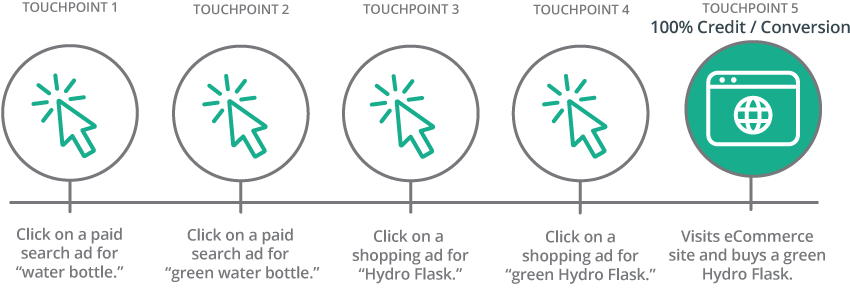
Last-click is easy to track because, with it, you only look at one action. But, last-click misses the value of all the other touchpoints along your customer’s journey.
First-Click Attribution
First-click attribution is also a single-click attribution model. First-click assigns all credit for a conversion to the first click the customer makes — regardless of how many clicks the customer makes after the first click and overall.
In our sample customer journey, first-click attribution gives all the credit for the eventual purchase to touchpoint 1.
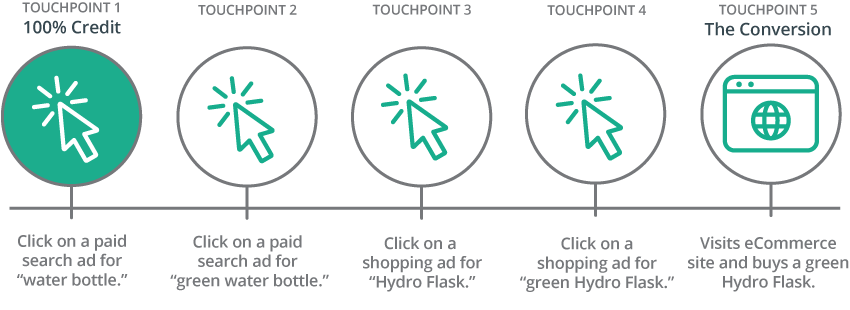
Multi-Touch Attribution Models
Multi-touch attribution is also called multi-click attribution. There are several multi-touch attribution models. Each gives credit for the eventual conversion to two or more touchpoints along the customer journey.
The most common multi-touch attribution models follow.
Linear Attribution
The linear attribution model is a multi-touch attribution model. It gives each touchpoint on a customer journey that ends in a conversion equal credit for the eventual conversion.
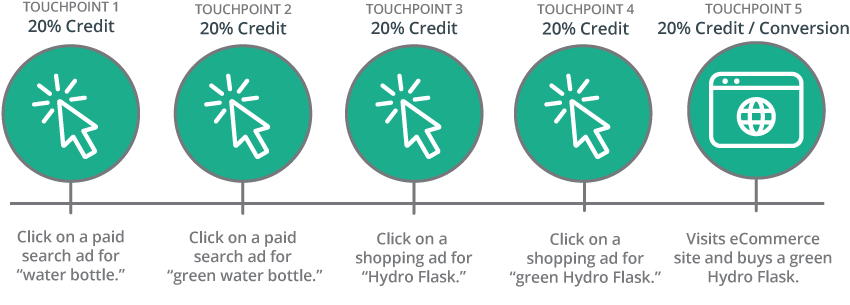
Read more about attribution. Find the default models for common ad platforms. And see which models the most popular ad platforms support in “The Basics and Value of Incrementality and Attribution for eCommerce” eBook.
Time Decay Attribution
The time decay attribution model is a multi-touch attribution model that gives each touchpoint a different percentage of credit. It gives the lowest percentage to the touchpoint farthest from the conversion and the highest percentage to the touchpoint nearest the conversion.
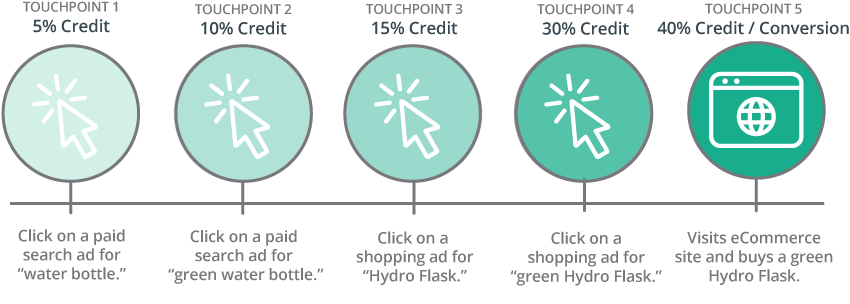
Position-Based Attribution
Position-based attribution is also called U-shaped attribution. This model gives 40% of the credit to the first and last touchpoints the customer makes. The remaining 20% is divided among the touchpoints in between.
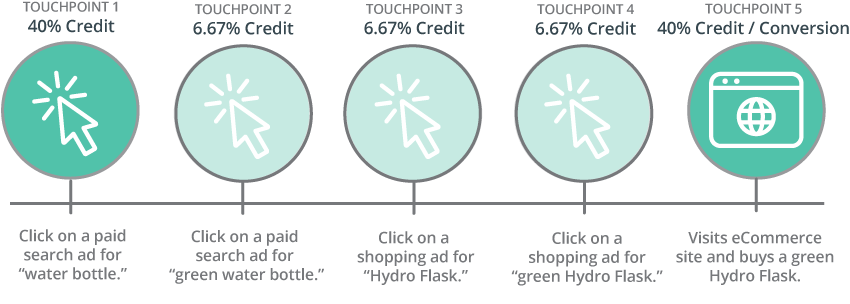
Data-Driven Attribution
The data-driven attribution model uses algorithms to analyze the touchpoints your customers make on the path to conversion to determine how much credit each touchpoint merits.
The algorithms identify patterns in the touchpoints your customers make toward conversion and give the most credit to the touchpoints that most often lead to a conversion.
In the following hypothetical sample, the algorithms find that the highest number of customers who buy a green Hydro Flask are those that click your “green water bottle” paid search ad and then the shopping ad for “green Hydro Flask.” The data-driven model gives the greatest credit to those touchpoints.
For each campaign you run, the data-driven model will give credit to different touchpoints on that journey because no two customer journeys are the same.
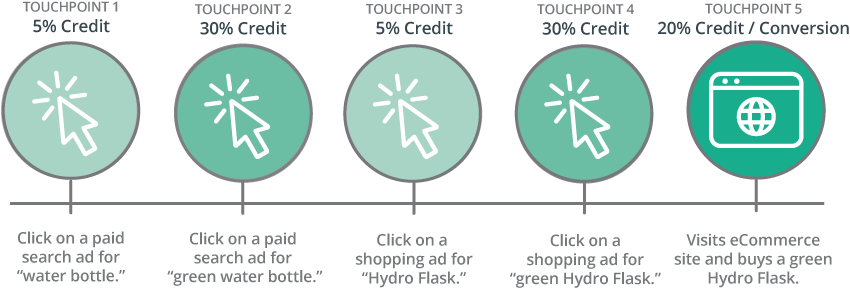
The data-driven model does require a minimum amount of data to analyze. For example, Google needs a minimum of 3,000 Google.com search clicks and at least 300 conversions in 30 days for you to use this model on Google. Other platforms have similar data minimums.
Also, while Google Ads supports a data-driven model and uses its findings for its own smart bidding, it doesn’t reveal what it finds to you, the user.
Why Multi-Touch Attribution Matters for Your Paid Media Success
Single-click attribution models have their place. You can use them to test the effectiveness of new creative or a specific part of your funnel. And they’re fine if you know your customer follows a short, simple customer journey.
A multi-touch attribution model though gives you more data to work with. So, for the most part, forget single-click attribution models. And use a multi-touch model.
Multi-Touch Attribution Gives You the Most Insight
When you know your customer’s full journey and use the right attribution model, you can maximize the success of your paid marketing efforts and drive more conversions. With a multi-touch model, you can collect data on multiple touchpoints and make better decisions for your future advertising efforts.
You can know what to pay for a bid on each click (or whatever conversion you’re using for that touchpoint). If an earlier touchpoint in your customer journey drives more conversions, you can bid accordingly.
Alternatively, you can let Google Smart Bidding or Google Smart Shopping bid for you if you’re willing to let them decide what you’ll pay per click without knowing why. If you want to know what you’re bidding and why, consider bidding technology in the Finch Advertising Management Platform with Campaign Optimization.
Reconsider our customer journey.

You know customers comparison shop and that different touchpoints assist others in the final conversion. If you use a single-click model, and you’ll never know that the conversion was the result of all of the touchpoints and not just that last one. You might stop advertising, assuming you didn’t need to because the last-click model made you think that your customer simply comes to your site to buy.
Then your sales plummet and you have to start over.
Multi-Touch Attribution Reveals the Value of Each Touchpoint
Multi-touch attribution models show you that each touchpoint within a channel has value and help you decipher the very best touchpoints. You can focus more ad spend on those.
Returning to our time-decay attribution model, say you or your platform set higher bids for the ads for touchpoints 3 and 4. Suddenly, you’re capturing more views on the touchpoints closest to conversion. Your return on ad spend or advertising cost of sale is better than ever and your number of conversions is up.

Bottom line: When you choose a multi-touch attribution model you have more data on more touchpoints and can make better decisions about what to pay for a bid on each click. You can also see that touchpoints earlier in your funnel do, in fact, assist your final conversion and justify your ad spend there.
Read more about attribution. Find the default models for common ad platforms. And see which models the most popular ad platforms support in “The Basics and Value of Incrementality and Attribution for eCommerce” eBook.






